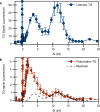Nanoscale polarization transient gratings
- PMID: 39737944
- PMCID: PMC11685567
- DOI: 10.1038/s41467-024-54799-6
Nanoscale polarization transient gratings
Abstract
Light manipulation at the nanoscale is essential both for fundamental science and modern technology. The quest to shorter lengthscales, however, requires the use of light wavelengths beyond the visible. In particular, in the extreme ultraviolet regime these manipulation capabilities are hampered by the lack of efficient optics, especially for polarization control. Here, we present a method to create periodic, polarization modulations at the nanoscale using a tailored configuration of the FERMI free electron laser and demonstrate its capabilities by comparing the dynamics induced by this polarization transient grating with those driven by a conventional intensity grating on a thin ferrimagnetic alloy. While the intensity grating signal is dominated by the thermoelastic response, the polarization grating excitation minimizes it, uncovering helicity-dependent responses previously undetected. We anticipate nanoscale polarization transient gratings to become useful for the study of physical, chemical and biological systems possessing chiral symmetry.
© 2024. The Author(s).
Conflict of interest statement
Competing interests: The authors declare no competing interests.
Figures





References
-
- Rotenberg, N. & Kuipers, L. Mapping nanoscale light fields. Nat. Photonics8, 919–926 (2014).
-
- Manjavacas, A., Zundel, L. & Sanders, S. Analysis of the limits of the near-field produced by nanoparticle arrays. ACS Nano13, 10682–10693 (2019). - PubMed
-
- Burresi, M. et al. Observation of polarization singularities at the nanoscale. Phys. Rev. Lett.102, 033902 (2009). - PubMed
-
- Zhao, R. et al. Nanoscale polarization manipulation and encryption based on dielectric metasurfaces. Adv. Opt. Mater.6, 1800490 (2018).
Grants and funding
- DE-SC0024339/DOE | SC | Basic Energy Sciences (BES)
- DE-SC0024339/DOE | SC | Basic Energy Sciences (BES)
- 328545488/Deutsche Forschungsgemeinschaft (German Research Foundation)
- 328545488/Deutsche Forschungsgemeinschaft (German Research Foundation)
- 328545488/Deutsche Forschungsgemeinschaft (German Research Foundation)
LinkOut - more resources
Full Text Sources

